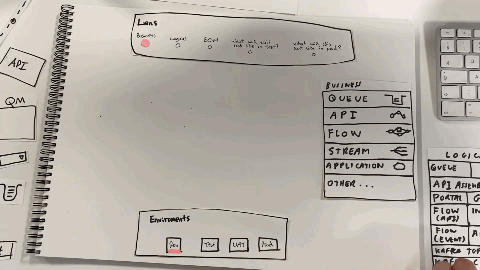Simplifying enterprise integration development
IBM Cloud Pak for Integration (CP4I) is an integration platform for building enterprise system connections.
Building integrations in CP4I was complex and could take months. Working solutions required several rounds of iterations with multiple deployments. Decisions were made across multiple teams with limited documentation.
We built a drag and drop canvas that empowers less technical users to build integrations and deploy as a single unit.
My role
UX Design lead
Use case
Online retailer PinkJeans Global uses IBM Cloud Pak for Integration to create a unified integration layer that connects their online store, Stripe, Salesforce, Netsuite ERP and Zendesk accounts.
Their custom integration layer triggers a complete automation sequence the moment a customer completes checkout: an internal API is called, inventory levels sync with NetSuite ERP, payments process through Stripe, international customs forms generate automatically, fraud detection systems validate the transaction, and Zendesk support tickets are created for order tracking.
Identify the problems
Building enterprise integrations sometimes took months. It required collaboration between business and development teams. Communication is often difficult due to varying levels of technical skills.
Developers also need to deploy multiple objects to get a single working integration, further exacerbating existing bottlenecks. Consequently, changes in between iterations are often left undocumented, making upgrades a headache.
To summarize
It takes too long to build a simple working integration.
The "as-is" experience
Low fi design explorations
Concept: different lenses for different users
Concept: boilerplates for non technical users
Align a global team
I led a hybrid workshop from our campus in the UK where most of the team was based, but colleagues in N. America and other parts of Europe had the option to join remotely for parts of it.
The goal of the workshop was to narrow down the design problems and align on a solution. By the end, we had created a prototype and concept tested with a few customers.
Hybrid set up
Preparing for a concept test
Concept: the CP4I canvas
The canvas includes toggleable notes for documenting build decisions. Drag-and-drop components that are linked on the canvas. Components that are configured through a slide-over form, with options to select reusable elements. Users can troubleshoot and deploy the entire integration as one unit. More technical users can switch back to a code view if they're more comfortable editing the code directly.
Conclusion
We achieved cross-team alignment and developed a unified story for stakeholders. Validation testing confirmed our direction while feedback shaped our experience-based roadmap.
Time to deploy a simple working integration was reduced from 2 hours to as little as 10 minutes.






